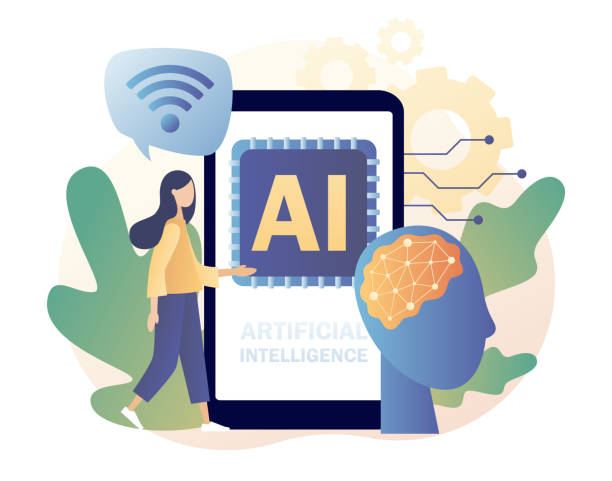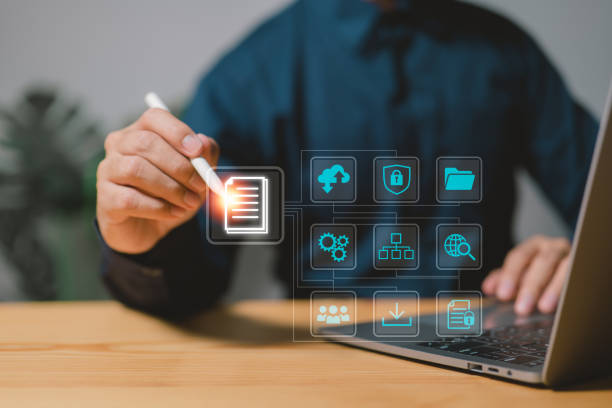Introduction to AI Robots: What They Are, History, and Basic Concepts
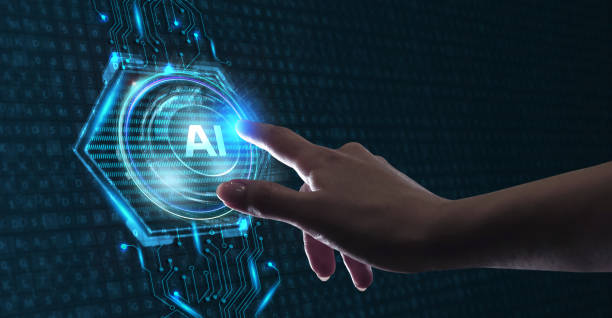
What is an AI Robot? A Journey into the World of Artificial Intelligence
#AI robot, a combination of two important fields of science and technology: robotics and artificial intelligence.
Simply put, an AI robot is a physical or virtual machine that uses #artificial_intelligence algorithms to perform tasks that typically require human intelligence.
These tasks can include learning, reasoning, problem-solving, natural language understanding, and pattern recognition.
AI robots can be used in a wide range of industries and applications, from manufacturing and customer service to healthcare and space exploration.
The history of this field goes back decades, when researchers first began to explore the possibility of combining robotics and artificial intelligence.
With advances in artificial intelligence, especially in the areas of machine learning and natural language processing, AI robots have become more complex and capable.
Today, we are witnessing the development of AI robots capable of performing complex tasks such as autonomous driving, disease diagnosis, and even creating works of art.
Key concepts in this field include machine learning algorithms, neural networks, natural language processing (NLP), and computer vision.
Machine learning algorithms allow robots to learn from data and improve their performance.
Neural networks are computational models inspired by the structure of the human brain and are used to solve complex problems.
NLP enables robots to understand and produce human language, while computer vision allows them to process and interpret images and videos.
Do you dream of a thriving online store but don’t know where to start?
RasaWeb is your comprehensive solution for e-commerce website design.
✅ Attractive and user-friendly design
✅ Increased sales and revenue⚡ Get a free consultation
Main Components of an AI Robot: Hardware, Software, and Control System

Main Components of an AI Robot
An AI robot consists of three main components: hardware, software, and a control system.
The robot’s hardware includes physical parts such as sensors, motors, arms, and other mechanical components.
Sensors are used to collect information from the surrounding environment, such as cameras, microphones, touch sensors, and proximity sensors.
Motors and arms are used for movement and performing physical tasks.
The type of hardware used in an AI robot depends on its specific application.
The robot’s software includes AI algorithms, the operating system, and application programs.
AI algorithms are used to process data collected by sensors, make decisions, and control the robot’s performance.
The robot’s operating system is a software platform that enables the execution of AI algorithms and applications.
Applications are designed to perform specific tasks such as navigation, object recognition, and human interaction.
An AI robot achieves high efficiency in its performance by using these software components.
The robot’s control system is responsible for coordinating and controlling the performance of both hardware and software.
This system includes a controller that receives commands from the software and sends control signals to the hardware.
The control system is also responsible for monitoring the robot’s performance and detecting and correcting errors.
The robot’s control system can be implemented in a centralized or distributed manner.
The interaction of these three components enables an AI robot to sense, think, and act within its environment.
With advancements in each of these areas, AI robots become more complex and capable, and can be used in a wider range of applications.
Types of AI Robots Based on Application and Capabilities
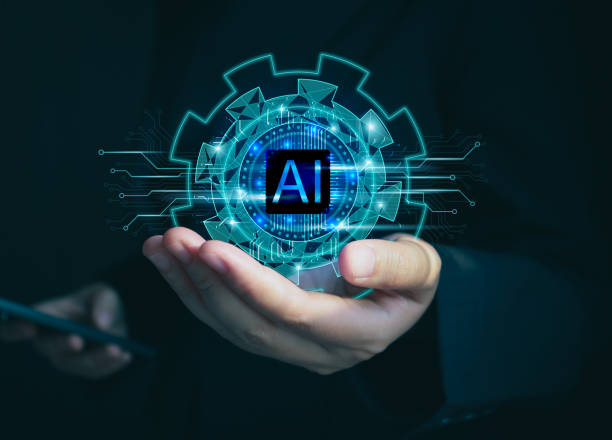
Categorization of AI Robot Types
AI robots are divided into different categories based on their applications and capabilities.
One of the most common classifications is based on the type of tasks the robot is capable of performing.
For example, industrial robots are used for repetitive and precise tasks in production lines, while service robots are designed to provide services to humans, such as cleaning, delivery, and elderly care.
Search and rescue robots are used to find and save people in dangerous situations such as earthquakes and fires.
Another classification is based on the robot’s level of autonomy.
Remote-controlled robots are operated by humans, while semi-autonomous robots can perform some tasks independently but still require human supervision and intervention.
Fully autonomous robots are capable of performing all their tasks without human intervention.
AI robots fall into the highest level of this classification.
Furthermore, robots can be categorized based on the type of artificial intelligence used in them.
Rule-based robots use predefined rules for decision-making, while machine learning-based robots use data to learn and improve their performance.
Hybrid robots use both approaches.
Neural network-based robots use artificial neural networks to process information and make decisions.
Finally, robots can be categorized based on their physical form.
Stationary robots remain in a fixed location, while mobile robots are capable of moving within their environment.
Humanoid robots are designed to resemble humans, while animal-like robots are designed to resemble animals.
AI robots are available in various forms, and choosing the appropriate type depends on the specific needs of each application.
| Robot Type | Application | Features |
|---|---|---|
| Industrial | Manufacturing, Packaging | High precision, High speed |
| Service | Cleaning, Delivery, Care | Human interaction, Autonomy |
| Search and Rescue | Finding and rescuing people | Resistance, Navigation capability |
Applications of AI Robots in Various Industries: Medicine, Manufacturing, Services, etc.
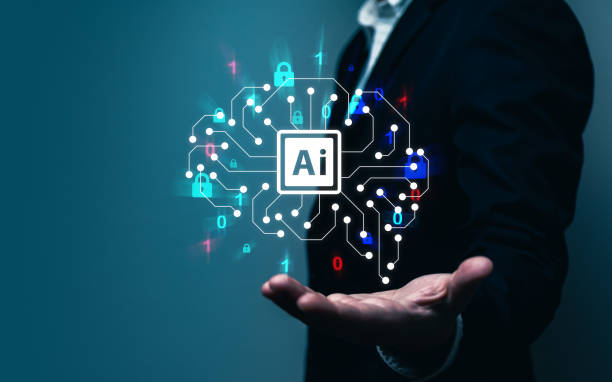
Wide Applications of AI Robots
AI robots have very widespread applications in various industries.
In the medical field, robots can be used for precise surgeries, assisting in patient rehabilitation, and providing remote care services.
In the manufacturing industry, robots can be used for repetitive and hazardous tasks, improving product quality, and increasing productivity.
In the service sector, robots can be used for customer service, delivery, and cleaning.
In education, AI robots can be used as teaching assistants to help students learn complex concepts and provide personalized feedback.
In agriculture, robots can be used for planting, harvesting, and irrigating crops.
Furthermore, AI robots are being developed for new and innovative applications.
For example, robots are being developed that can be used for space exploration, pollution cleanup, and assisting people with disabilities.
The potential of AI robots to change the world is immense.
However, the use of AI robots also comes with challenges.
One of the most significant challenges is concern about job displacement due to automation.
Another challenge is ensuring the safety and security of AI robots.
Ultimately, it must be ensured that AI robots are used ethically and responsibly.
Do visitors leave your e-commerce site before making a purchase? Don’t worry anymore! With RasaWeb’s professional e-commerce website design services, solve the problem of not converting visitors into customers forever!
✅ Significant increase in conversion rates and sales
✅ Unique and engaging user experience
⚡ Contact us now for a free consultation!
Advantages and Disadvantages of Using AI Robots: Opportunities and Challenges
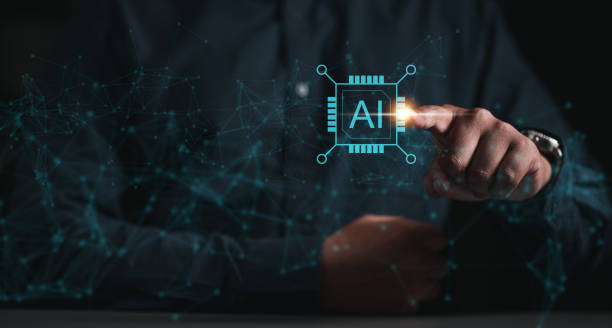
Advantages and Disadvantages of AI Robots
The use of #AI_robots offers many advantages.
Robots can perform tasks with greater accuracy and speed than humans.
They can work in dangerous and difficult conditions, such as toxic environments or confined spaces.
Robots can work continuously without fatigue, leading to increased productivity.
AI robots can help reduce costs, improve quality, and increase safety.
However, the use of AI robots also has disadvantages.
One of the most significant drawbacks is the high cost of purchasing, installing, and maintaining robots.
Robots may not be as flexible and adaptable as humans and may not be able to perform effectively in unexpected situations.
There are concerns about job losses due to automation.
AI robots have caused these concerns.
Furthermore, the use of AI robots also brings ethical and social challenges.
It must be ensured that robots are designed and used safely and responsibly.
Decisions must be made regarding the accountability of robots in case of errors or damage.
The impact of robots on society and the workforce must be considered.
Despite these challenges, the potential of AI robots to improve human lives is immense.
By properly managing opportunities and challenges, the benefits of robots can be leveraged, and their risks can be mitigated.
When utilized correctly, AI robots can be very beneficial.
The Future of AI Robots: Advancements, Innovations, and Prospects

A Look at the Future of AI Robots
The future of AI robots is bright and full of potential.
With advancements in artificial intelligence, robotics, and related technologies, robots will become more complex, capable, and versatile.
It is expected that robots will be used in a wider range of industries and applications and will play a more significant role in our daily lives.
One of the most important future advancements is the development of more autonomous robots.
These robots will be able to operate in complex and unpredictable environments without human intervention.
Autonomous robots can be used for tasks such as self-driving, space exploration, and elderly care.
Other innovations include the development of soft robots, wearable robots, and collaborative robots.
Soft robots are made of flexible materials and can operate in tight and sensitive environments.
Wearable robots can be attached to the human body and assist people with daily tasks.
Collaborative robots are designed to work alongside humans and can cooperate on shared tasks.
AI robots are progressing and developing day by day.
The vision for AI robots is a world where robots are seamlessly integrated into our lives, assisting us with various tasks.
Robots can help improve the quality of life, increase productivity, and solve complex problems.
However, to achieve this vision, ethical, social, and technical challenges related to AI robots must be addressed.
AI robots must be developed in compliance with ethical laws and regulations.
Ethical and Social Challenges Related to AI Robots: Accountability, Privacy, and Security

Ethical and Social Challenges of AI Robots
The development and use of AI robots bring significant ethical and social challenges that must be addressed.
One of the most important challenges is the accountability of robots.
If a robot makes a mistake or harms someone, who will be responsible? Is the robot’s manufacturer, the robot’s user, or the robot itself responsible? These questions do not yet have clear answers and require further discussion and examination.
Another challenge is protecting individuals’ privacy.
Robots can collect a lot of information about us, such as our shopping habits, interests, and location.
How can this information be protected, and how can its misuse be prevented? Laws and regulations must be established to protect individuals’ privacy from robots.
Robot security is also a critical concern.
What happens if a robot is hacked or controlled by a cyber attacker? A hacked robot can be used to perform malicious acts such as espionage, sabotage, or physical attacks.
Strong security measures must be adopted to protect robots from cyber attacks.
An AI robot must be designed to be resilient against cyber attacks.
Furthermore, there are concerns about the impact of robots on the workforce.
Will robots lead to job losses? If so, how can people who lose their jobs be helped? Policies must be developed to train and retrain the workforce for new jobs in the robotic economy.
AI should not lead to widespread unemployment.
Key Considerations for Designing and Developing a Successful AI Robot
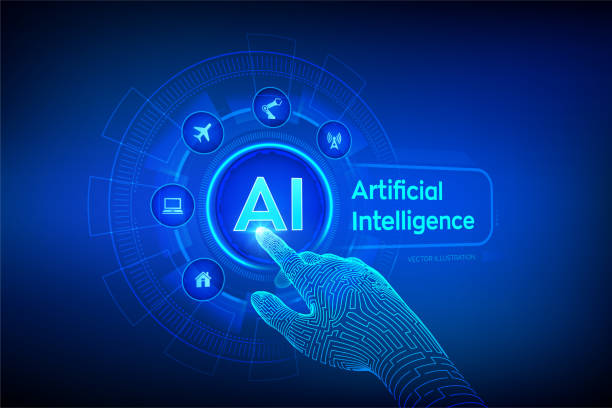
Designing and Developing AI Robots
To design and develop a successful AI robot, key considerations must be taken into account.
First, a specific and clear goal for the robot must be defined.
The robot should be designed to perform a particular task, and its performance should be measurable and evaluable.
The AI robot should be designed in a way that meets the user’s needs.
Secondly, an appropriate architecture for the robot must be chosen.
The robot’s architecture should allow for the integration of hardware, software, and the control system.
The robot’s architecture should be scalable and extensible so that new capabilities can be added in the future.
An AI robot must have a robust and stable architecture.
Thirdly, suitable AI algorithms must be used.
AI algorithms should be compatible with the intended task and perform well under various conditions.
AI algorithms should be continuously trained and improved to optimize the robot’s performance.
An AI robot must use the best AI algorithms.
| Key Point | Description |
|---|---|
| Clear Goal | Defining a clear and measurable goal for the robot |
| Suitable Architecture | Choosing a scalable and extensible architecture |
| Appropriate Algorithms | Using compatible and high-performing algorithms |
Finally, the robot must be thoroughly tested to ensure it functions correctly.
Tests should be conducted under various conditions and with diverse data.
Test results should be used to improve the robot’s design and development.
An AI robot must be fully tested before being released to the market.
Falling behind in the competition with large online stores?
RasaWeb, with professional e-commerce website design, brings your business online and increases your market share!
✅ Increased brand credibility and customer trust
✅ Easy shopping experience leading to more sales
⚡ Act now to receive a free website design consultation!
Legal and Regulatory Considerations Related to AI Robots

Laws and Regulations for AI Robots
With the increasing use of AI robots, legal and regulatory considerations related to this technology are also gaining more importance.
Laws and regulations must be established to govern the development, use, and sale of robots.
These laws should address issues such as accountability, privacy, security, and safety of robots.
AI robots must be developed and used in accordance with existing laws and regulations.
One of the main challenges is determining accountability in case of an error or damage caused by a robot.
Will the robot’s manufacturer, the robot’s user, or the robot itself be responsible? Some countries are considering new laws to establish robot accountability.
For example, some proposals include creating an insurance fund to compensate for damages caused by robots.
AI robots should not be used without clear accountability.
Privacy is also a significant concern.
Robots can collect a lot of information about us, such as our shopping habits, interests, and location.
How can this information be protected, and how can its misuse be prevented? Laws and regulations must be established to limit the collection and use of information by robots.
AI robots must respect individuals’ privacy.
Robot security is also a critical concern.
What happens if a robot is hacked or controlled by a cyber attacker? Strong security measures must be adopted to protect robots from cyber attacks.
An AI robot must be resistant to cyber attacks.
Resources and References for Learning More About AI Robots: Books, Articles, Courses, and Websites

AI Robot Learning Resources
If you are interested in learning more about AI robots, many resources are available to you.
There are many books on robotics, artificial intelligence, and machine learning that you can use to gain basic knowledge.
Numerous scientific and conference papers on the latest advancements in AI robotics are published, which you can access through scientific databases like Google Scholar.
AI robotics is a popular field for learning.
Many online and in-person courses on robotics and artificial intelligence are available for you to attend.
Some of these courses are offered by reputable universities and educational institutions.
Numerous websites also provide free information and tutorials on robotics and artificial intelligence.
AI robots require continuous learning.
Additionally, by participating in conferences and events related to robotics and artificial intelligence, you can meet experts in the field and stay informed about the latest achievements and innovations.
You can also connect with other AI robotics enthusiasts and share your experiences by joining online communities and discussion groups.
AI robotics is a dynamic and evolving field.
Some useful resources include
* Books: “Artificial Intelligence: A Modern Approach” by Stuart Russell and Peter Norvig, “Machine Learning” by Tom Mitchell
* Scientific Databases: Google Scholar, IEEE Xplore
* Online Courses: Coursera, edX, Udacity
* Websites: Robotics Business Review, The Robot Report
AI robots continue to learn using various resources
Frequently Asked Questions
| Question | Answer |
|---|---|
| What is an AI robot? | It is a robot that uses artificial intelligence capabilities to understand the environment, reason, learn, and make decisions to perform complex tasks independently. |
| What is the main difference between a regular robot and an AI robot? | AI robots can learn and adapt to their environment, while regular robots usually operate based on fixed, predefined programming. |
| In what fields are AI robots used? | In fields such as industry (production lines), medicine (robotic surgery), services (customer support, smart vacuum cleaners), exploration (space and underwater), and entertainment. |
| How do AI robots learn? | They acquire new skills through Machine Learning and Deep Learning algorithms, by analyzing large data and identifying patterns. |
| Can AI robots have emotions? | Currently, no. They can identify or simulate emotions, but they do not experience actual emotions like humans. |
| What are the most important advantages of using AI robots? | Increased productivity, reduced human error, performing dangerous or repetitive tasks, and providing innovative and efficient services. |
| What challenges exist in the development of AI robots? | The need for abundant and high-quality data, complexity of algorithms, ethical issues, cybersecurity, and high research and development costs. |
| Are AI robots dangerous for humans? | With adherence to safe design principles and ethical regulations, no. Concerns are more related to social and economic impacts such as changes in the job market. |
| What is an example of an AI robot in daily life? | Smart robotic vacuum cleaners (like Roomba) that automatically map and clean homes, or smart voice assistants (like Siri and Alexa). |
| How is the future of AI robots predicted? | They are expected to become smarter, more autonomous, and capable of more complex interactions with humans, playing a more prominent role in industry, medicine, transportation, and daily life. |
And other advertising services by RasaWeb Advertising Agency:
- Smart Marketing Automation: An effective tool for digital branding with the help of real data.
- Smart Sales Automation: A fast and efficient solution for increasing click-through rates, focusing on Google Ads management.
- Smart Digital Advertising: Designed for businesses seeking to attract customers through Google Ads management.
- Smart Advertising Campaign: Professional optimization for digital branding using SEO-driven content strategy.
- Smart Google Ads: Professional optimization for campaign management using real data.
And over hundreds of other services in the field of online advertising, advertising consultation, and organizational solutions.
Online Advertising | Advertising Strategy | Advertorials
References
Fundamentals of Robotics and Artificial Intelligence
AI News and Articles on Zoomit
The Impact of Artificial Intelligence on the Future of Jobs
Advanced Applications of Artificial Intelligence
? Are you ready for your business to shine in the digital space? RasaWeb Afarin, by providing comprehensive digital marketing services including corporate website design, SEO, and social media management, paves your path to success.
📍 Tehran, Mirdamad Street, next to Bank Markazi, Kazeroun Jonoubi Alley, Ramin Alley, No. 6

